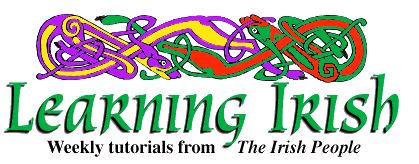
Irish Lesson 4
|
We began on the verb "tá" in Lesson 2, and we will continue with it now. Here is the entire present tense:
Tá mé (TAW* may*), I am
Níl mé (NEEL may*), I am not
An bhfuil mé? (un VWIL may*), am I? To give you fluency and practice in pronunciation, we now introduce a progressive drill. Repeat the drill several times when the lessons call for it. Each time you repeat it, it becomes easier. The drill takes you through a verb or grammar form progressively, changing from question to negative to declarative and back to the question form. Remember to form a mental picture for each sentence. Here is the basic form: An bhfuil mé sa ghairdín? (un VWIL may* suh gahr-DEEN), Am I in the garden? Níl mé sa ghairdín (NEEL may* suh gahr-DEEN), I am not in the garden. Tá tú sa ghairdín (TAW* too suh gahr-DEEN), You are in the garden. An bhfuil tú sa ghairdín? (un VWIL too suh gahr-DEEN), Are you in the garden? Níl tú sa ghairdín (NEEL too suh gahr-DEEN), You are not in the garden. Tá sé sa ghairdín (TAW* shay* suh gahr-DEEN), He is in the garden. An bhfuil sé sa ghairdín? (un VWIL shay* suh ghar-DEEN), Is he in the garden? Go on from here. Your last sentence will be: Tá mé sa ghairdín (TAW* may* suh gahr-DEEN), I am in the garden.
Vocabulary
Masculine nouns
Feminine nouns
Other words and phrases
Conversation Seán (shaw*n): Dia's Muire duit, a Bhríd (DEE-uhs MWIR-uh git, uh VREED) Conas tá sibh go léir? (KUN-uhs TAW* shiv goh lay*r) Hello, Bridget. How are you all? Bríd: Táimid go maith (TAW*-mid goh MAH), agus conas tá tú féin? (AH-guhs KUN-uhs TAW* too fay*n). We are well, and how are you yourself? Seán: &Oactue;O, ar fheabhas (oh er OUS). Nach breá an lá é? (nahk* bir-RAW un LAW* ay*). Oh, excellent. Isn't it a fine day? Bríd: Is breá, go deimhin (is bir-RAW*, goh DEYE-in) Tá an ghrian ag soilsiú. (taw* un YREE-uhn uh SEYEL-shoo), agus tá an aimsir go hálainn. (taw* un EYEM-sheer goh HAW*-lin). It is fine, certainly. The sun is shining and the weather is beautiful. Seán: Níl an aimsir chomh fuar agus a bhí sé inné. (neel un EYEM-sheer hoh FOO-uhr AH-guhs uh vee shay* in-YAY). The weather is not as cold as it was yesterday. Bríd: Agus níl an lá chomh fliuch agus a bhí sé inné. (AH-guhs neel an LAW* hoh flyuk* AH-guhs uh vee shay* in-YAY). And the day is not as wet as it was yesterday. Seán: Tá orm dul abhaile anois, a Bhríd. (TAW* OH-ruhm duhl uh-VWAHL-e uh-NISH, uh VREED). Féach, tá sé a cúig a chlog beagnach. (FAY*-uhk*, TAW* shay* un KOO-ig uh K*LUHG BYUHG-nahk*). I must go home now, Bridget. Look, it is almost five o'clock. Bríd: Slán leat (slaw*n lat) Good-bye. Seán: Slán agat, a Bhríd. ( slaw*n uh-GUHT, uh VREED). Good-bye, Bridget. Note: "Slán agat" (health be at you) is said to someone staying behind. "Slán leat "(health be with you) is said to someone going away. (c) 1997 The Irish People. May be reprinted with credit. |